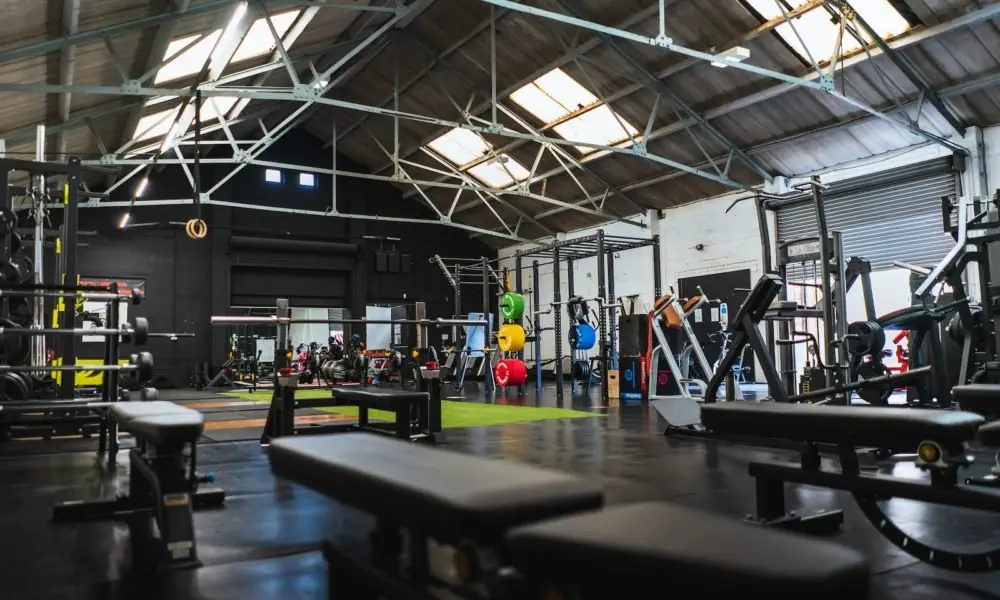Top Tips and Strategies for Starting a Gym Business Successfully
Are you passionate about fitness and looking to turn your expertise into a profitable business venture? Starting a gym business requires careful planning and execution to ensure success and profitability. In this comprehensive guide, we’ll explore expert tips and strategies to help you get started on the path to entrepreneurship. From creating a solid gym business plan to choosing the right location and equipment, we’ll cover everything you need to know to start a successful gym business.
Key Takeaways:
- Starting a gym business requires careful planning and execution
- A solid gym business plan is essential for success
- Choosing the right location is crucial to attract customers
- Investing in quality equipment and creating an inviting facility is important for customer satisfaction
- Building a strong team and fostering a sense of community among members is key to long-term success
Setting Your Goals and Vision
Starting a gym business can be an exciting and rewarding venture, but it’s important to begin with a clear vision and well-defined goals. Follow these gym startup tips and steps to start a gym successfully:
Conduct Market Research
Before opening a fitness center or studio, it’s important to conduct thorough market research to identify your target audience and competition. This will help you understand the needs and preferences of potential customers, as well as determine the ideal location for your gym.
To conduct market research:
- Use online resources such as Google Trends or social media analytics to identify trends and search volume related to fitness and gym services in your area.
- Survey potential customers and ask about their fitness habits, preferences, and challenges, as well as what they look for in a gym.
- Visit your competitors and assess their offerings, pricing, and customer experience.
Identify Your Unique Selling Proposition
Once you have a clear understanding of the market and competition, you can begin to identify your gym’s unique selling proposition (USP). Your USP is what sets you apart from other gyms and makes you stand out to potential customers.
To identify your USP:
- Consider your target audience and what they value in a gym. For example, if your target audience is busy professionals, your USP could be 24/7 access or state-of-the-art equipment.
- Look for gaps in your local market and offer services that are not currently available in your area.
- Highlight your gym’s strengths, such as highly qualified personal trainers or a welcoming, community-focused atmosphere.
Create a Compelling Business Plan
With a clear understanding of your market, competition, and USP, you can begin to create a comprehensive business plan. Your business plan should include details on your gym’s offerings, target audience, marketing strategy, and financial projections.
Your business plan should:
- Outline your gym’s mission, vision, and core values.
- Include a detailed marketing strategy, including how you plan to attract and retain customers.
- Outline your pricing structure and financial projections for the first few years of operation.
“Starting a gym business takes careful planning and consideration. By setting clear goals and creating a well-defined vision, you’ll be better equipped to turn your passion for fitness into a successful venture.”
Choosing the Right Location
When it comes to starting a fitness business, choosing the right location is key to its success. Whether you’re opening a fitness center or starting a fitness studio, your location should be accessible, visible and in a prime demographic area.
Factors to Consider
- Competitor analysis: Research the competition in the area. Identifying the strengths and weaknesses of existing gyms in the area can help you differentiate your business and attract customers.
- Accessibility: Choose a location that is easy to access for your customers. A location with ample parking and nearby public transportation is ideal.
- Demographics: Understand your target audience and choose a location that caters to their needs. For example, if you’re targeting young professionals, consider opening your gym near business districts or apartment complexes.
Choosing the Right Space
Once you’ve identified a potential location, it’s important to assess the space to ensure it’s a good fit for your gym business. Consider the following:
| Factors to Consider | Details |
|---|---|
| Size and layout | Make sure the space has enough square footage to accommodate the equipment and facilities you plan to offer. Ensure that there’s enough space for customers to move around freely. |
| Natural light and ventilation | Having good natural light and ventilation can help create a pleasant and inviting environment for your customers. |
| Noise level | Consider the type of equipment you’ll be using and the noise level it generates. You don’t want your gym to be disruptive to the surrounding area. |
Opening a fitness center or starting a fitness studio can be a daunting task, but with the right location and space, you can set yourself up for success. Remember to take your time and conduct thorough research to make an informed decision that maximizes your chances of attracting customers.
Equipment and Facility Setup
One of the most critical aspects of building a successful gym business is selecting the right equipment and setting up your facility in a way that maximizes functionality and space.
Essential Equipment for a Gym
The equipment you choose for your gym will impact the type of members you attract. Ensure that you purchase equipment that is appropriate for your target audience and aligns with their fitness goals.
Tip: Consider purchasing equipment that is versatile and can be used for a variety of exercises. This will allow you to maximize your space and accommodate the needs of different members.
Some essential equipment for a gym includes:
| Equipment Type | Examples |
|---|---|
| Cardiovascular Machines | Treadmills, Ellipticals, Bikes, Rowing Machines |
| Strength Training Machines | Weight Benches, Squat Racks, Cable Machines, Smith Machines |
| Free Weights | Dumbbells, Barbells, Kettlebells, Weight Plates |
| Functional Training Equipment | Battle Ropes, Suspension Trainers, Medicine Balls, Plyometric Boxes |
Designing an Inviting and User-Friendly Space
The design and layout of your gym can significantly impact the experience of your members. A poorly designed gym can lead to overcrowding, confusion, and equipment damage.
Tip: Plan your gym layout to reflect your brand identity and philosophy. Make sure to create dedicated spaces for different types of exercises and offer ample space for member movement.
Consider the following when designing your gym:
- Lighting and Color Scheme
- Flow of Traffic
- Cleanliness and Sanitation
- Locker Rooms and Showers
- Equipment Placement and Accessibility
By making the right equipment choices and designing your gym with your members in mind, you can create an appealing and comfortable space that keeps your members coming back.
Staffing and Hiring
When it comes to starting a fitness studio or gym, having the right staff in place can make all the difference. Here are some key gym startup tips for staffing and hiring:
Identify Which Roles You Need
Before posting job listings, it’s important to determine which roles you need to fill. For example, you may need personal trainers, front desk staff, maintenance personnel, and group fitness instructors.
Recruit High-Quality Talent
Recruiting high-quality talent starts with crafting an effective job listing that clearly outlines the responsibilities and requirements of each role. Be sure to also post your job listings across multiple channels, such as job boards and social media platforms. This will help you reach a wider audience and attract top talent.
Provide Adequate Training
Once you’ve hired your staff, it’s important to provide them with adequate training and resources to ensure they can perform their roles effectively. This may include on-the-job training, access to instructional materials, and ongoing coaching and support.
Reward and Retain Top Talent
To attract and retain the best employees, it’s important to offer competitive salaries and benefits packages, as well as opportunities for advancement and career growth. Additionally, recognizing and rewarding top performers can help foster a strong company culture and increase employee satisfaction and retention.
Marketing and Promotion
Marketing and promotion are vital components of a successful gym business plan. A well-rounded marketing strategy is essential to draw in new customers and retain existing members. Follow these tips for launching a gym:
- Identify your target audience: Understanding who your gym is geared towards is the first step in crafting a targeted marketing strategy. Consider factors such as age, gender, fitness level, and lifestyle habits to tailor your messaging to your ideal customer.
- Develop a strong brand identity: Your gym’s brand should be memorable, consistent, and aligned with your values and mission. Use visually engaging graphics, logos, and color schemes across all marketing channels to establish a strong brand presence.
- Utilize online marketing channels: Digital marketing is crucial in today’s age of technology. Use social media platforms like Facebook and Instagram to showcase your gym’s facilities, classes, and events. Create a Google My Business profile to improve your gym’s visibility in search engine results.
- Offer incentives and promotions: Encourage potential customers to try out your gym by offering discounts, free trials, or referral programs. This helps build rapport with your target audience and draws them into your gym community.
- Host special events: Organize events such as open houses, fitness challenges, or charity drives to attract new customers and give existing members a sense of community. Partner with other businesses or influencers to increase your reach and exposure.
“Marketing and promotion are crucial for attracting and retaining gym members.”
Remember to continually evaluate and adapt your marketing strategies to optimize their effectiveness. By following these tips for launching a gym, you can build a strong brand presence and community that attracts and retains loyal members.
Financial Considerations and Funding
Starting a gym business requires careful financial planning and consideration. As a gym entrepreneur, you must not only budget for startup costs but also estimate ongoing expenses and revenue.
One of the first steps in securing funding for your gym business is to create a comprehensive business plan that outlines your financial projections and operations. You can use this plan to approach potential investors and lenders who may be interested in supporting your business.
| Expenses | Example Costs |
|---|---|
| Equipment | $50,000-$100,000+ |
| Property Lease/Rent | $5,000-$10,000/month |
| Insurance | $1,000-$2,000/year |
| Utilities | $1,000-$2,000/month |
| Marketing and Advertising | $1,000-$5,000/month |
When it comes to funding your gym business, you may choose to self-finance using personal savings or loans from family and friends. Alternatively, you can explore other options such as bank loans, crowdfunding, or venture capital.
Managing cash flow is essential when starting a gym business. You must have a clear understanding of your expenses and income, and set membership prices that align with your overall business goals. It’s important to develop strategies to generate consistent revenue and reduce expenses where possible.
Remember, starting a gym business requires careful planning and financial consideration. With the right approach and an eye for detail, you can turn your passion for fitness into a successful and profitable gym business.
Building a Strong Member Community
Building a strong member community is one of the most important gym business strategies to ensure success. Providing a friendly, welcoming environment where members can connect with each other and feel supported in their fitness journeys is key to increasing engagement and retention.
Organizing Group Classes and Social Events
Group classes and social events are great ways to foster a sense of community within your gym. Offer a variety of fitness classes to cater to different preferences and skill levels, such as yoga, Pilates, and spinning. You can also organize social events like fitness challenges, charity runs, and healthy cooking classes to bring members together outside of the gym.
Implementing Member Referral Programs
Encourage your members to refer their friends and family to your gym by offering rewards for successful referrals. This not only helps to increase membership but also strengthens your member community as referrals often come from those who enjoy and believe in your gym’s atmosphere and culture.
Creating a Welcoming and Inclusive Environment
It’s important to create a gym environment that is welcoming and inclusive to all members, regardless of their age, gender, or fitness level. Make sure that your staff is trained to provide excellent customer service and that your gym policies reflect your commitment to promoting diversity and inclusivity.
| Tip: | Offer a free trial period or give new members a tour of your gym to help them feel comfortable and confident in their decision to join. |
|---|
By following these gym business strategies for building a strong member community, you’ll be able to create a gym culture that promotes engagement, loyalty, and long-term success.
Conclusion
Thank you for taking the time to read our guide on starting a gym business. We hope you found the information useful and informative. Remember, starting a gym business requires hard work, dedication, and careful planning.
As you embark on this journey, make sure to develop a solid gym business plan, choose the right location, create a welcoming environment, and market your gym effectively. It’s also important to stay on top of financial considerations and funding, and to build a loyal member community.
Starting a gym business can be a challenging but rewarding experience. By following the tips and strategies outlined in this guide, you can set yourself up for success in the competitive fitness industry. Good luck on your entrepreneurial journey!
FAQ
What should be included in a gym business plan?
A comprehensive gym business plan should include sections on market analysis, target audience, business model, marketing and promotion strategies, financial projections, and operational details.
How important is market research when starting a gym business?
Market research is crucial as it helps you understand your target audience, identify the competition, assess demand for fitness services in your area, and make informed decisions about pricing, branding, and marketing strategies.
What factors should I consider when choosing a location for my gym?
When choosing a location for your gym, consider factors such as accessibility, parking availability, proximity to residential areas or office buildings, competition analysis, and demographic characteristics of the surrounding population.
What type of equipment do I need to start a gym?
The equipment needed for a gym will depend on the type of fitness services you plan to offer. However, basic equipment such as cardio machines, weightlifting equipment, exercise mats, and mirrors for functional training are typically essential.
How should I approach staffing and hiring for my gym business?
When hiring for your gym, consider the roles you need to fill, such as personal trainers, front desk staff, and cleaning personnel. Look for individuals with relevant experience and certifications, and provide training and development opportunities to ensure they deliver exceptional service.
What are some effective marketing strategies for promoting a gym?
Effective marketing strategies for promoting a gym include creating a strong online presence through social media marketing and a well-designed website, offering introductory membership discounts, partnering with local businesses, and implementing referral programs to incentivize member referrals.
How can I secure funding for my gym startup?
Funding options for a gym startup may include personal savings, bank loans, investors, crowdfunding, or government grants. It’s important to have a clear business plan and financial projections to present to potential investors or lenders.
How can I build a strong sense of community among my gym members?
To build a strong member community, organize group fitness classes, host social events, encourage member interactions through a welcoming and inclusive environment, and implement member referral programs that reward members for bringing in new customers.
You have visited 0 post(s)



















